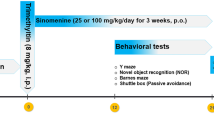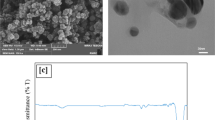Abstract
Betanin, a natural food colorant with powerful antioxidative properties, has not been studied in terms of neurodegenerative disease intervention. Therefore, the present study aimed to investigate the neuroprotective effects of betanin against trimethyltin chloride (TMT) -induced neurodegeneration in mice. Forty male ICR mice were randomly divided into four groups: Sham-veh, TMT-veh, TMT-Bet50 and TMT-Bet100. In the TMT groups, neurodegeneration was induced with a one-time intraperitoneal injection of 2.6 mg/kg TMT. Betanin-treated groups (Bet) were given oral doses of 50 or 100 mg/kg dissolved in normal saline solution. Administrations were started 24 h prior to TMT injection and continued for 2 weeks. Anxious behavior and spatial cognition were evaluated, respectively. After behavioral tests, brain oxidative status, hippocampal histology and choline acetyltransferase (ChAT) activity were evaluated. Results showed that TMT significant induce anxious behavior and spatial learning and memory deficits (p < 0.05). These were found concurrently with significant decreases in CA1 ChAT activity, brain tissue catalase (CAT) and superoxide dismutase (SOD) activities with significant increase in hippocampal CA1 degeneration (p < 0.05). Betanin 100 mg/kg exhibited significant anxiolytic effect, preventive effect on CA1 degeneration and CA1 ChAT activity alteration as well as improvement of spatial learning and memory deficits (p < 0.05). These were found concurrently with significant increases of reduced glutathione, CAT and SOD activities as well as the decrease in malondialdehyde (p < 0.05). We conclude that betanin 100 mg/kg exhibits neuroprotective effects against TMT-induced neurodegeneration in mice via its anti-oxidative properties, protective against hippocampal CA1 degeneration and ChAT activity alteration. Therefore, betanin is interesting in further neurodegenerative therapeutic study and applications.





Similar content being viewed by others
References
Albasher G, Alsaleh AS, Alkubaisi N, Alfarraj S, Alkahtani S, Farhood M, Alotibi N, Almeer R (2020) Red Beetroot Extract Abrogates Chlorpyrifos-Induced Cortical Damage in Rats Oxid Med Cell Longev 2020:2963020–2963020 https://doi.org/10.1155/2020/2963020, 13
Ali SF, LeBel CP, Bondy SC (1992) Reactive oxygen species formation as a biomarker of methylmercury and trimethyltin neurotoxicity. Neurotoxicology 13:637–648
Allegra M, Tesoriere L, Livrea MA (2007) Betanin inhibits the myeloperoxidase/nitrite-induced oxidation of human low-density lipoproteins. Free Radic Res 41:335–341 773149631
Baumgart M, Snyder HM, Carrillo MC, Fazio S, Kim H, Johns H (2015) Summary of the evidence on modifiable risk factors for cognitive decline and dementia: A population-based perspective. Alzheimer's & Dementia 11:718–726. https://doi.org/10.1016/j.jalz.2015.05.016
Besser R, Kramer G, Thumler R, Bohl J, Gutmann L, Hopf HC (1987) Acute trimethyltin limbic-cerebellar syndrome. Neurology 37:945–950. https://doi.org/10.1212/wnl.37.6.945
Campbell NL, Unverzagt F, LaMantia MA, Khan BA, Boustani MA (2013) Risk factors for the progression of mild cognitive impairment to dementia. Clinics in geriatric medicine 29:873–893. https://doi.org/10.1016/j.cger.2013.07.009
Chang LW (1984) Trimethyltin induced hippocampal lesions at various neonatal ages. Bull Environ Contam Toxicol 33:295–301. https://doi.org/10.1007/bf01625546
Chiu C-H et al (2018) Erinacine A-enriched Hericium erinaceus mycelium produces antidepressant-like effects through modulating BDNF/PI3K/Akt/GSK-3β signaling in mice. Int J Mol Sci 19:341. https://doi.org/10.3390/ijms19020341
Corvino V, Geloso MC, Cavallo V, Guadagni E, Passalacqua R, Florenzano F, Giannetti S, Molinari M, Michetti F (2005) Enhanced neurogenesis during trimethyltin-induced neurodegeneration in the hippocampus of the adult rat. Brain Research Bulletin 65:471–477. https://doi.org/10.1016/j.brainresbull.2005.02.031
Dillon GM, Qu X, Marcus JN, Dodart JC (2008) Excitotoxic lesions restricted to the dorsal CA1 field of the hippocampus impair spatial memory and extinction learning in C57BL/6 mice. Neurobiol learn Mem 90:426–433. https://doi.org/10.1016/j.nlm.2008.05.008
Esatbeyoglu T, Wagner AE, Schini-Kerth VB, Rimbach G (2014) Betanin--a food colorant with biological activity. Mol Nutr Food Res 59:36–47. https://doi.org/10.1002/mnfr.201400484
Fereshtehnejad SM et al (2019) Burden of neurodegenerative diseases in the eastern Mediterranean region, 1990-2016: findings from the global burden of disease study 2016. Eur J Neurol 26:1252–1265. https://doi.org/10.1111/ene.13972
Geloso MC, Corvino V, Michetti F (2011) Trimethyltin-induced hippocampal degeneration as a tool to investigate neurodegenerative processes. Neurochem Int 58:729–738. https://doi.org/10.1016/j.neuint.2011.03.009
Geloso MC, Vinesi P, Michetti F (1998) Neuronal subpopulations of developing rat hippocampus containing different calcium-binding proteins behave distinctively in trimethyltin-induced neurodegeneration. Exp Neurol 154:645–653. https://doi.org/10.1006/exnr.1998.6949
Hadipour E, Fereidoni M, Tayarani-Najaran Z (2020) Betanin attenuates oxidative stress induced by 6-OHDA in PC12 cells via SAPK/JNK and PI3 K pathways. Neurochem Res 45:395–403. https://doi.org/10.1007/s11064-019-02927-w
Ishikawa K, Kubo T, Shibanoki S, Matsumoto A, Hata H, Asai S (1997) Hippocampal degeneration inducing impairment of learning in rats: model of dementia? Behav Brain Res 83:39–44. https://doi.org/10.1016/S0166-4328(97)86043-3
Tural K, Ozden O, Bilgi Z, Kubat E, Ermutlu CS, Merhan O, Tasoglu I (2020a) The protective effect of betanin and copper on heart and lung in endorgan ischemia reperfusion injury. Bratisl Lek Listy 121:211–217. https://doi.org/10.4149/BLL_2020_032
Kang JY, Park SK, Guo TJ, Ha JS, Lee DS, Kim JM, Lee U, Kim DO, Heo HJ (2016) Reversal of Trimethyltin-induced learning and memory deficits by 3,5-Dicaffeoylquinic acid oxidative medicine and cellular longevity 2016:6981595 https://doi.org/10.1155/2016/6981595
Killin LOJ, Starr JM, Shiue IJ, Russ TC (2016) Environmental risk factors for dementia: a systematic review. BMC geriatrics 16:175–175. https://doi.org/10.1186/s12877-016-0342-y
Kim MJ, Choi SJ, Lim ST, Kim HK, Heo HJ, Kim EK, Jun WJ, Cho HY, Kim YJ, Shin DH (2007) Ferulic acid supplementation prevents trimethyltin-induced cognitive deficits in mice. Bioscience, biotechnology, and biochemistry 71:1063–1068. https://doi.org/10.1271/bbb.60564
Kotake Y (2012) Molecular mechanisms of environmental organotin toxicity in mammals. Biol pharm bull 35:1876–1880. https://doi.org/10.1248/bpb.b212017
Krajka-Kuz'niak V, Paluszczak JA, Szaefer H, Baer-Dubowska W (2013) Betanin, a beetroot component, induces nuclear factor erythroid-2-related factor 2-mediated expression of detoxifying/antioxidant enzymes in human liver cell lines. British Journal of Nutrition 110:2138–2149. https://doi.org/10.1017/s0007114513001645
Lamballais S, Muetzel RL, Ikram MA, Tiemeier H, Vernooij MW, White T, Adams HHH (2020) Genetic burden for late-life neurodegenerative disease and its association with early-life lipids. Brain, Behavior, and Cognition Front Psychiatry 11:33. https://doi.org/10.3389/fpsyt.2020.00033
Laursen B, Mørk A, Plath N, Kristiansen U, Bastlund JF (2014) Impaired hippocampal acetylcholine release parallels spatial memory deficits in Tg2576 mice subjected to basal forebrain cholinergic degeneration. Brain research 1543:253–262. https://doi.org/10.1016/j.brainres.2013.10.055
Lee S, Yang M, Kim J, Kang S, Kim J, Kim JC, Jung C, Shin T, Kim SH, Moon C (2016) Trimethyltin-induced hippocampal neurodegeneration: A mechanism-based review. Brain Res Bull 125:187–199. https://doi.org/10.1016/j.brainresbull.2016.07.010
Little AR, Miller DB, Li S, Kashon ML, O'Callaghan JP (2012) Trimethyltin-induced neurotoxicity: gene expression pathway analysis, q-RT-PCR and immunoblotting reveal early effects associated with hippocampal damage and gliosis. Neurotoxicol Teratol 34:72–82. https://doi.org/10.1016/j.ntt.2011.09.012
Magalingam KB, Radhakrishnan A, Ping NS, Haleagrahara N (2018) Current Concepts of Neurodegenerative Mechanisms in Alzheimer's Disease. BioMed Research International 2018:3740461. https://doi.org/10.1155/2018/3740461
Manyagasa N, Thong-asa W (2019) The Effects of P-Hydroxycinnamic Acid in Ameliorating Spatial Learning and Flexibility Deficits in Rats with Chronic Cerebral Hypoperfusion Sains Malaysiana 48:2623–2631 https://doi.org/10.17576/jsm-2019-4812-03
Martin EI, Ressler KJ, Binder E, Nemeroff CB (2009) The neurobiology of anxiety disorders: brain imaging, genetics, and psychoneuroendocrinology. Psychiatr Clin north am 32:549–575. https://doi.org/10.1016/j.psc.2009.05.004
Milaeva ER, Tyurin VY, Gracheva YA, Dodochova MA, Pustovalova LM, Chernyshev VN (2006) Protective effect of Meso-Tetrakis-(3,5-di-tert-butyl-4-hydroxyphenyl)porphyrin on the in vivo impact of Trimethyltin chloride on the Antioxidative defense system. Bioinorg Chem Appl 64927. https://doi.org/10.1155/bca/2006/64927
Paxinos G, Franklin K (2008) The mouse brain in stereotaxic coordinates. 3rd edn
Raz L, Knoefel J, Bhaskar K (2015) The neuropathology and cerebrovascular mechanisms of dementia Journal of cerebral blood flow and metabolism : official journal of the International Society of Cerebral Blood Flow and Metabolism 36:172–186 https://doi.org/10.1038/jcbfm.2015.164
Sakamula R, Thong-Asa W (2018) Neuroprotective effect of p-coumaric acid in mice with cerebral ischemia reperfusion injuries. Metab Brain Dis 33:765–773. https://doi.org/10.1007/s11011-018-0185-7
Somredngan S, Thong-Asa W (2018) Neurological Changes in Vulnerable Brain Areas of Chronic Cerebral Hypoperfusion Mice Ann Neurosci 24:233–242 https://doi.org/10.1159/000481789
Tan D, Wang Y, Bai B, Yang X, Han J (2015) Betanin attenuates oxidative stress and inflammatory reaction in kidney of paraquat-treated rat. Food Chem Toxicol 78:141–146. https://doi.org/10.1016/j.fct.2015.01.018
Thong-Asa W, Bullangpoti V (2020) Neuroprotective effects of Tiliacora triandra leaf extract in a mice model of cerebral ischemia reperfusion. Avicenna J Phytomed 10:202–212
Thong-asa W, Tilokskulchai K (2014) Neuronal damage of the dorsal hippocampus induced by long-term right common carotid artery occlusion in rats Iran J Basic Med Sci 17:220–226
Tural K, Ozden O, Bilgi Z, Kubat E, Ermutlu CS, Merhan O, Tasoglu I (2020b) The protective effect of betanin and copper on spinal cord ischemia-reperfusion injury. J Spinal Cord Med:1–7. https://doi.org/10.1080/10790268.2020.1737788
Vieira Teixeira da Silva D, Dos Santos Baiao D, de Oliveira Silva F, Alves G, Perrone D, Mere Del Aguila E, V MFP (2019) Betanin, a natural food additive: stability, Bioavailability, Antioxidant and Preservative Ability Assessments Molecules 24 https://doi.org/10.3390/molecules24030458
Vorhees CV, Williams MT (2006) Morris water maze: procedures for assessing spatial and related forms of learning and memory. Nat Protoc 1:848–858. https://doi.org/10.1038/nprot.2006.116
Wachiryah TA, Hathaipat L (2018) Enhancing effect of Tiliacora triandra leaves extract on spatial learning, memory and learning flexibility as well as hippocampal choline acetyltransferase activity in mice. Avicenna J Phytomed 8:380–388
Win-Shwe TT, Yamamoto S, Fujitani Y, Hirano S, Fujimaki H (2008) Spatial learning and memory function-related gene expression in the hippocampus of mouse exposed to nanoparticle-rich diesel exhaust. Neurotoxicology 29:940–947. https://doi.org/10.1016/j.neuro.2008.09.007
Yegambaram M, Manivannan B, Beach TG, Halden RU (2015) Role of environmental contaminants in the etiology of Alzheimer's disease: a review. Current Alzheimer research 12:116–146. https://doi.org/10.2174/1567205012666150204121719
Zhang Q, Pan J, Wang Y, Lubet R, You M (2012) Beetroot red (betanin) inhibits vinyl carbamate- and benzo(a)pyrene-induced lung tumorigenesis through apoptosis. Mol Carcinog 52:686–691. https://doi.org/10.1002/mc.21907
Acknowledgments
This research was supported by the Project in Zoology grant from the Department of Zoology and the URMF grant from Faculty of Science, Kasetsart University.
Author information
Authors and Affiliations
Corresponding author
Ethics declarations
Conflict of interest
The authors declare no conflicts of interest.
Additional information
Publisher’s note
Springer Nature remains neutral with regard to jurisdictional claims in published maps and institutional affiliations.
Rights and permissions
About this article
Cite this article
Thong-asa, W., Prasartsri, S., Klomkleaw, N. et al. The neuroprotective effect of betanin in trimethyltin-induced neurodegeneration in mice. Metab Brain Dis 35, 1395–1405 (2020). https://doi.org/10.1007/s11011-020-00615-1
Received:
Accepted:
Published:
Issue Date:
DOI: https://doi.org/10.1007/s11011-020-00615-1




